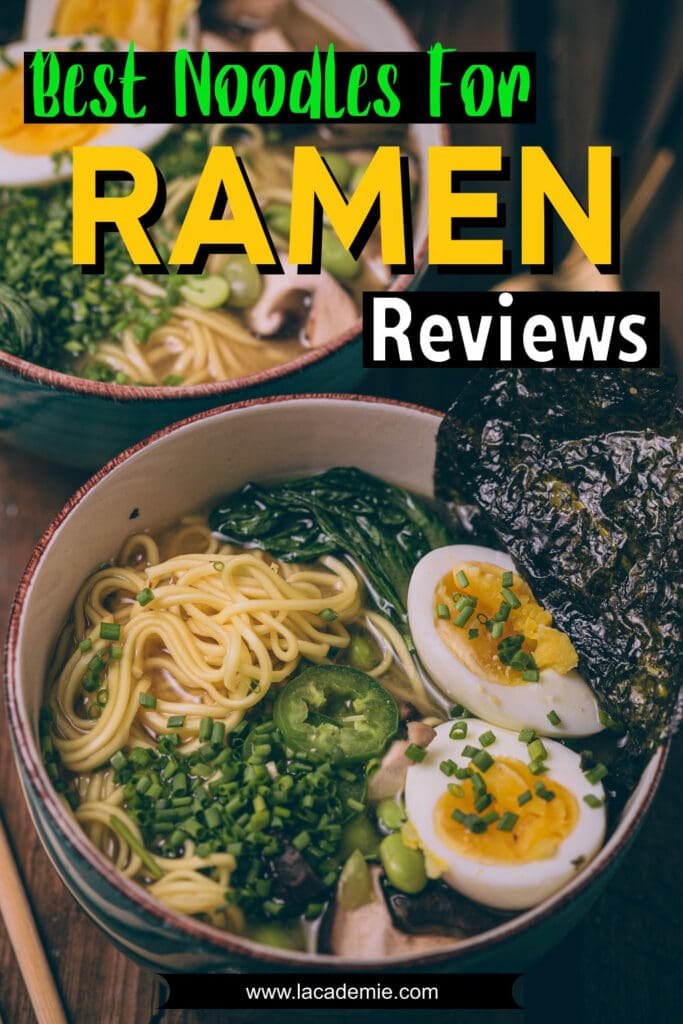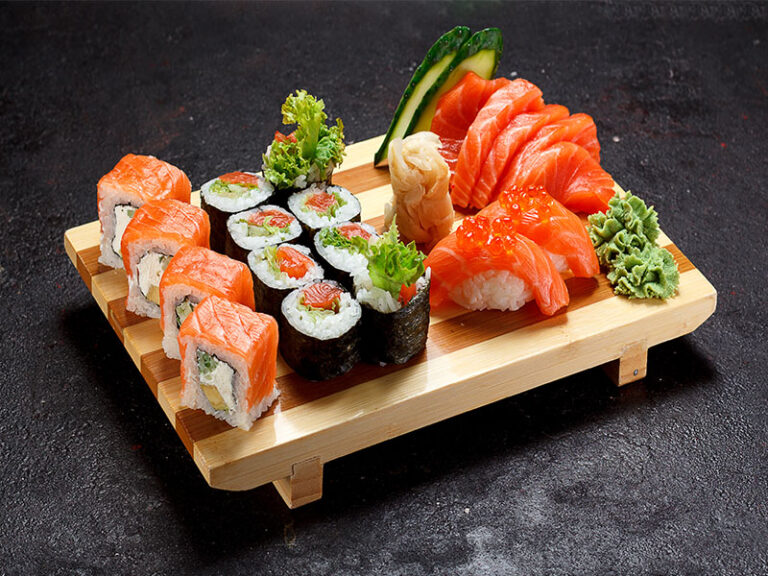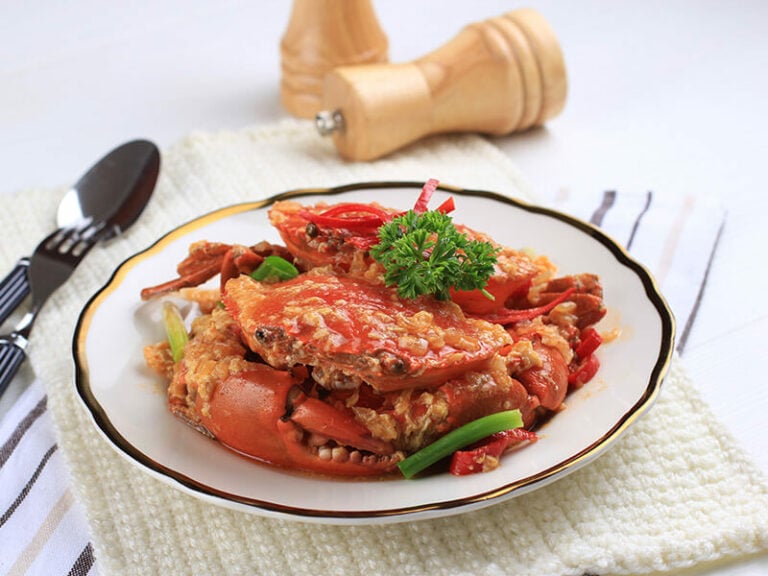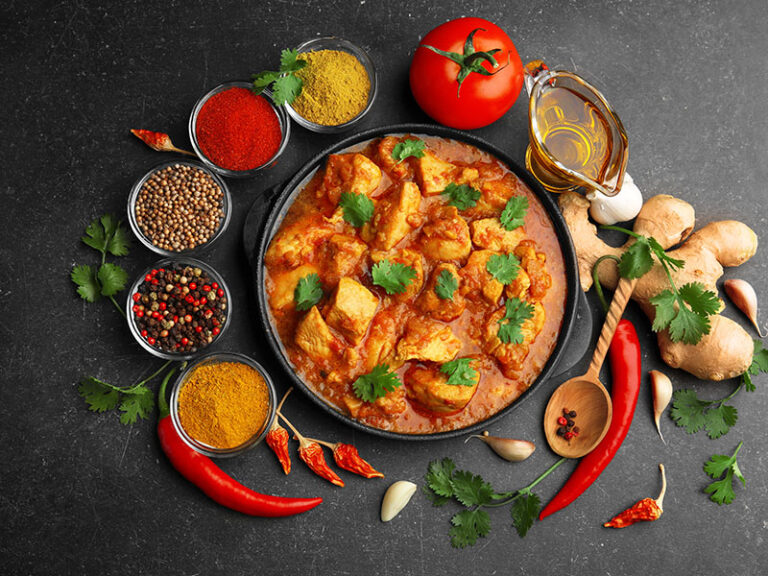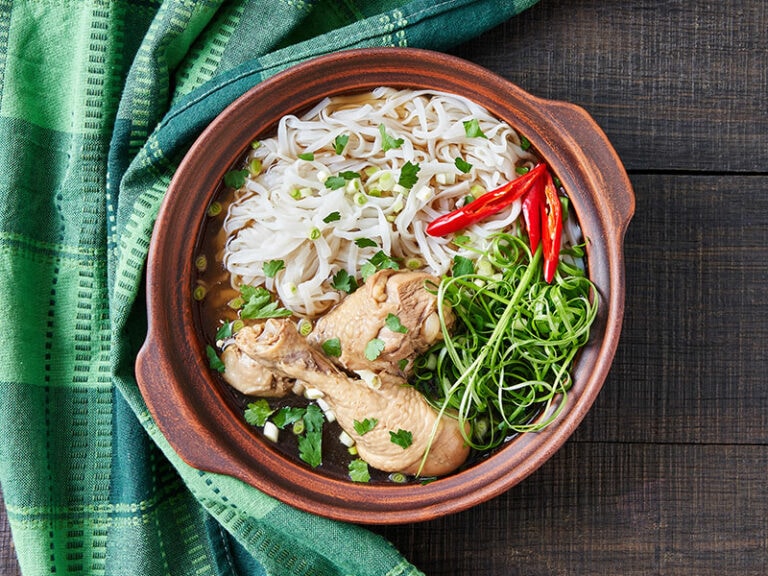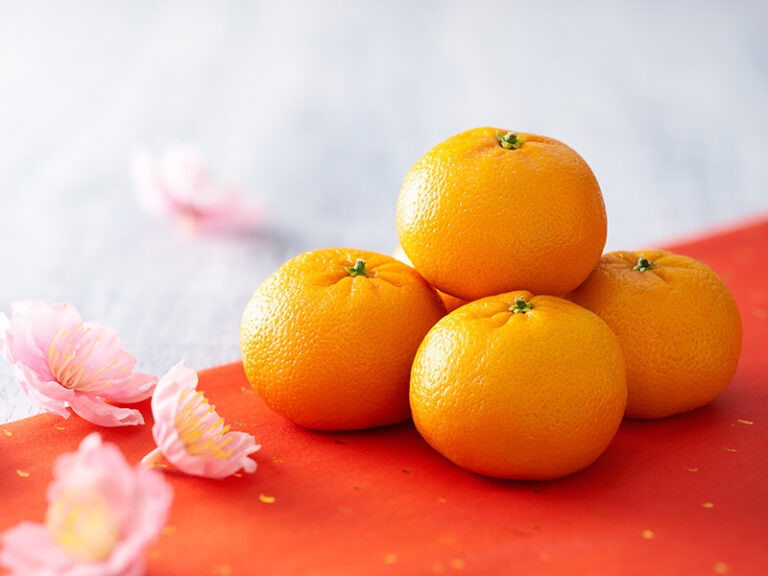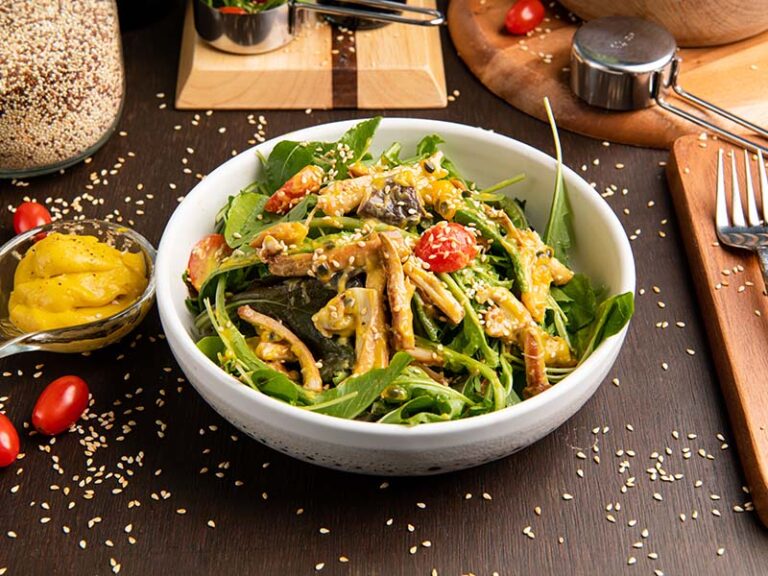Have you ever wondered what the best noodles for ramen are? If not, you should start paying attention to that field since noodles are one of the most critical factors for your ramen bowl.
You may also hear that professional ramen chefs take years to master their own noodles. However, with the homemade ramen version, you don’t need to take that long, especially when you have these high-quality noodles.
So, don’t hesitate anymore, let’s get started!
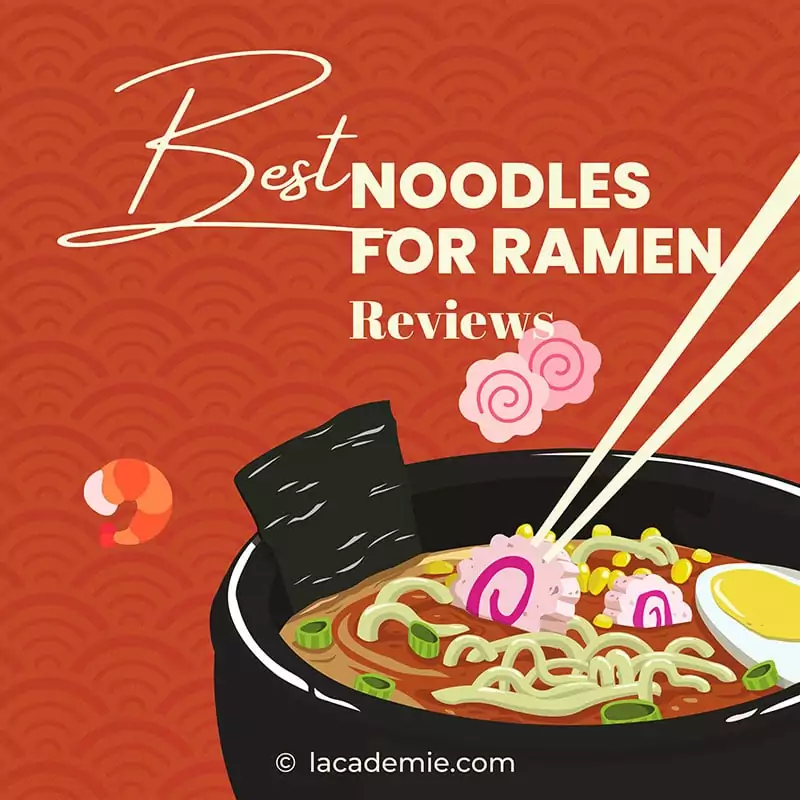
First, Let’s Find Out What Ramen Is!
It’s hard to believe there is any person who hasn’t heard of ramen in their life. Originating as a cheap dish for the masses, ramen has now become one of the iconic recipes from Japan. Anyone who comes to this country will be suggested to have a go at this dish first.
Despite its fame, ramen is actually a simple dish with just noodles, broth, and various toppings. However, thanks to its simplicity, chefs can be as creative as they want. In fact, in Japan, every region has its special variety of ramen.
However, based on the flavor, ramen basically consists of the following types.
Shio Ramen (Ramen With Salted Broth)
You must have guessed how this ramen tastes right from its name. “Shio” in Japanese means “salt,” so the stock is seasoned with salt.
Also, chefs often use chicken or vegetables to make the broth, so it will look transparent and taste refreshing. Even if they use pork, they won’t boil it too long to avoid ruining the soup.
Shoyu Ramen (Ramen With Soy-Sauce Broth)
Compared to shio ramen, the broth in this ramen looks browner as it uses soy sauce instead of salt. Aside from that, this ramen stock is pretty similar to the previous type, though some restaurants may use pork or seafood to make their soup.
Miso Ramen (Ramen With Miso-Based Broth)
For those who don’t know miso, it’s a Japanese seasoning paste containing fermented soybeans. There are different brands of miso paste depending on the ingredients, flavor, cooking purposes, etc.
In this miso ramen, the miso paste will be mixed with the broth. Thus, this ramen’s stock will look muddier with a more robust flavor. Miso ramen is often related to Sapporo city, Japan.
While there are many ingredients to use in place of miso out there, nothing can quite replicate the flavor of this Japanese condiment. Therefore, I suggest investing in some premium miso paste if you ever plan to make miso ramen at home.
Tonkotsu Ramen (Ramen With Pork Broth)
While those three ramen types often use broth made of chicken or vegetable, tonkotsu ramen mainly uses pork bones for its stock. Thus, you can consider it the thickest among those ramen.
Tsukemen Ramen (Dipping Ramen)
Not all ramen comes in a bowl filled with hot broth. And this tsukemen is a typical example. This dish contains ramen, and hot soup served separately. You will dip the noodles into the broth to enjoy it.
Hiyashi Chuka (Cold Ramen)
Also known as reimen in Southern Japan and hiyashi ramen in Hokkaido, this cold ramen is Japanese people’s favorite dish in summer. It contains noodles with various ingredients, mostly vegetables, all dressed in soy sauce and rice vinegar.
What Kinds Of Noodles Can Be Used For Ramen?
Basically, ramen noodles contain these four essential ingredients: wheat flour, salt, water, and kansui, which is alkaline mineral water including sodium carbonate, and potassium carbonate.
Kansui is the main reason for ramen noodles’ yellow color and firm texture, though nowadays, some replace it with eggs for the same result.
Many people also wonder whether they can eat ramen without cooking. While it’s technically safe to eat raw ramen, especially the instant type, I personally think that a perfectly cooked bowl of ramen tastes much better.
Best Ramen Brands That You Should Buy
The next part is about what ideal brands that you can consider. If you are new to this type of noodle, you should check these names. I bet you will love their products.
Hakubaku
Hakubaku is a brand of the Kokumotsu company. The term “Hakubaku” in Japanese means “white barley”. The company’s philosophy is to enhance the value of your meal with their nutritious and tasty grain-based products.
Nissin
Nissin Food is a big Japanese company specializing in instant noodles and convenient foods. Its popularity in the USA is huge so you can easily find them in many supermarkets. Their markets in other countries are also impressive, such as Brazil, China, Hong Kong, and more.
Maruchan
It is a Japanese-American brand name with a wide array of noodle varieties, like cup noodles or instant ramen noodles. Established in 1953 in Japan, Maruchan spread its market to America in 1972. Today, Maruchan is one of the top companies in this industry thanks to its high-quality products.
Lotus Foods
Lotus Foods is a California-based company operating since 1995. They specialize in natural foods like rice (with a lot of varieties) and rice noodles. Their products not only promote human diet but also improve environmental welfare.
Quick Answer: The Best Noodles For Ramen In 2023
Overall, the best noodles for ramen are Hakubaku ramen noodles as they offer a diversity of different noodles with high quality. Or, if you want a product with a more reasonable price, Maruchan soy sauce noodles are the appropriate option.
And this list here will serve you some more good suggestions, so you’ll have more choices for yourself.
- Best Overall: Hakubaku 9.5oz Organic Japanese Noodles For Ramen
“Japanese ramen noodles, natural ingredients verified by USDA and Kosher, cooking instructions on the package.” - Best Budget: Maruchan Soy-Sauce Flavor Noodles For Ramen
“Noodles made of wheat flour, soy sauce flavor, low price, quick to cook.” - Best Tonkotsu Ramen: Ichiran Tonkotsu-Flavored Noodles For Ramen
“Hakata-style tonkotsu ramen with firm noodles, Ichiran signature red spicy sauce, Japan-imported product.” - Best Shoyu Ramen: Annie Chun’s Shoyu-Flavored Noodles For Ramen
“American product, soy sauce soup with different frozen toppings, vegan-friendly, microwave-safe package.” - Best Shio Ramen: Sapporo Ichiban 3.6oz Shio-Flavored Noodles For Ramen
“Japanese instant noodles with salt-flavored broth, a packet of sesames attached, no trans fat.” - Best Instant Noodles/Best Miso Ramen: Nissin RAOH Miso-Flavored Noodles For Ramen
“Instant noodles with premium quality, triple-layer noodles, broth full of umami.” - Best Air-Dried Ramen Noodles: Hime 25.4oz Japanese Noodles For Ramen
“Japanese ramen noodles from wheat flour, thick and chewy, large quantity.” - Best Fresh Noodles: Sun Noodles 10oz Kaedama Noodles For Ramen
“Fresh handmade noodles; not containing dairy products, artificial colors, and preservatives; affordable cost; can be refrigerated or frozen.” - Best Organic Ramen: Ocean’s Halo 8.4oz Organic Noodles For Ramen
“Air-dried noodles verified by USDA, Vegan-friendly, no trans fat and saturated fat” - Best Healthy Option: Lotus Foods Organic Millet & Brown Rice Noodles For Ramen
“Noodles made of millet and brown rice, non-GMO, gluten-free, low sodium and MSG content.”
Best Noodles For Ramen Comparison Chart 2023
If you are short of time, you may need this comparison chart among the best noodles for ramen. It has all the vital features of these noodle products so that you can compare them quickly.
Top 10 Best Noodles For Ramen Reviews 2023
All the previous parts are just appetizers, the main dish is this review of these ten best noodles for ramen. In this part, you’ll find everything about these products, including their strong and weak points.
1. Hakubaku 9.5oz Organic Japanese Noodles For Ramen (504)
(Best Overall)

If you still aren’t sure what noodles to cook ramen, this Hakubaku product is an ideal solution, as it contains organic Japanese ramen noodles made of nothing but wheat flour, salt, and water. This way, you’ll know immediately what authentic ramen tastes like.
And don’t get scared when you don’t know how to cook these noodles. On the package, there is straightforward instruction that even beginners can succeed in the first time with this yummy Japanese dish. So don’t sweat it if you’ve never tried your hand at this food before.
Also, if you’re concerned about health matters, all the ingredients in this Hakubaku package are USDA, and Kosher certified.
Key Features:
- Organic noodles
- USDA and Kosher certificates
- Each serving wrapped individually
Pros
- Natural ingredients
- Clear preparing instruction
- Authentic Japanese flavor
- Great texture when cooked
Cons
- The noodles may get broken if not handled properly
Product Specifications:
| Brand | Hakubaku |
| Weight | 9.5oz |
| Dimensions | 9.06 inches x 2.64 inches x 1.1 inches |
| Number Of Serving | 5 servings/package |
| Serving Size | 2oz |
| Calories/Serving | 200 |
| Carb/Serving | 38 |
| Sodium/Serving | 550mg |
2. Maruchan Soy-Sauce Flavor Noodles For Ramen
(Best Budget)

If you are a student seeking an economical ramen noodle choice, search no further than this Maruchan product. At a reasonable price, you get several noodle packages enough to satisfy your hungry stomach.
And just because it’s low-cost, that doesn’t mean it isn’t delicious. These Maruchan noodles are already pre-seasoned with soy sauce, a traditional Japanese ramen flavor, so you can enjoy them right away without any further seasonings.
Key Features:
- Wheat-flour noodles
- Already flavored with soy sauce
- Done in three minutes
Pros
- Budget-friendly
- Suitable for people with busy life
- Flavorful taste
- Versatile uses
Cons
- A bit less salty compared to regular soy sauce ramen
Product Specifications:
| Brand | Maruchan |
| Weight | 3oz |
| Dimensions | 15.5 inches x 10 inches x 4.2 inches (24 packs) |
| Number Of Serving | 2 servings/package |
| Serving Size | 1.5oz |
| Calories/Serving | 190 |
| Carb/Serving | 26g |
| Sodium/Serving | 890mg |
Wondering if you should buy Maruchan soy sauce noodles? This is your answer!
3. Ichiran Tonkotsu-Flavored Noodles For Ramen (1755)
(Best Tonkotsu Ramen)

Anyone who loves Japanese cuisine will surely know about the famous ramen chain named Ichiran. And now, you don’t have to go to Japan to enjoy this well-known ramen. With this noodle pack, it only takes several minutes for a piping hot ramen bowl.
Not to mention, these Ichiran noodles are totally different from other instant brands, thanks to Ichiran signature red sauce. Moreover, this ramen is 100% Hakata-style one with more wheat flavor and thin noodles.
Key Features:
- Noodles made of wheat flour
- Hakata-style tonkotsu flavor
- Containing original spicy sauce
- Come from Japan
Pros
- Unique, rich flavor
- Firm and smooth noodles
- Contain English instructions on the package
- Restaurant quality
Cons
- Sodium content is a bit high
Product Specifications:
| Brand | Ichiran |
| Weight | 08.kg/1.750 lbs |
| Dimensions | 9.84 inches x 7.09 inches x 1.54 inches |
| Number Of Serving | 5 servings/package |
| Serving Size | 5.3oz |
| Calories/Serving | 474 |
| Carb/Serving | 59.5g |
| Sodium/Serving | 3000mg |
You’d want to buy these Ichiran tonkotsu ramen noodles right away!
4. Annie Chun’s Shoyu-Flavored Noodles For Ramen
(Best Shoyu Ramen)

Coming from one of the best-selling noodles brands – Annine Chun’s, there’s no doubt about this product’s flavor. Additionally, it’s a 100% USA product, so its flavor will be more familiar for those who aren’t used to Japanese taste yet.
Moreover, with Annine Chun’s noodles, you don’t even need to cook them. Just follow the instructions on the package, you’ll get a hot ramen bowl after a few minutes microwaving. Super convenient for busy days, right?
And if you want to try other flavors, this brand also provides you with several choices like Annie Chun’s Tonkotsu Ramen or Annine Chun’s Spicy Miso Ramen.
Key Features:
- Pre-cooked noodles with shoyu (soy sauce) broth
- Vegan product with no GMO
- Contain toppings: corn, carrot, and green onions
- Microwave-proof container
Pros
- Simple and convenient cooking
- Flavorful broth
- Suitable for American palate
- Quick to prepare
Cons
- The bowl can become very hot after microwaving
Product Specifications:
| Brand | Annie Chun’s |
| Weight | 5.4oz (6 packs) |
| Dimensions | 17.09 inches x 6.61 inches x 6.38 inches |
| Number Of Serving | 1 serving/package |
| Serving Size | 5.4oz |
| Calories/Serving | 240 |
| Carb/Serving | 49g |
| Sodium/Serving | 890mg |
5. Sapporo Ichiban 3.6oz Shio-Flavored Noodles For Ramen
(Best Shio Ramen)

When it comes to shio ramen, you can’t leave the Sapporo Ichiban brand out. Inspired by the shio ramen from Hakodate, it has replicated that distinct flavor into this product.
The broth of Sapporo Ichiban ramen is not overwhelming but well-balanced between the saltiness and sweetness from vegetables. Prepare some Japanese dishes made with veggies to serve with the ramen if you want a more balanced and nutrition-packed meal.
These noodles also come with a packet of sesames for an extra nutty and rich taste for your dish.
Key Features:
- Ramen with shio soup
- Japanese product
- Contain sesames as a topping
Pros
- Authentic flavor
- Light, easy-to-eat broth
- Suitable for various toppings
- Not contain any trans fat
Cons
- Pretty high in sodium level
Product Specifications:
| Brand | Sapporo Ichiban |
| Weight | 17.5 oz (6 packs) |
| Dimensions | 13.7 inches x 13.7 inchesx 5.47 inches |
| Number Of Serving | 1 servings/package |
| Serving Size | 3.6oz |
| Calories/Serving | 480 |
| Carb/Serving | 200g |
| Sodium/Serving | 2090mg |
6. Nissin RAOH Miso-Flavored Noodles For Ramen
(Best Instant Noodles/Best Miso Ramen)

Just like its name indicates (raoh is combined by two words: “ramen” and “ou,” which means “king”), this Nissin product is really the king of instant ramen.
Right from the first taste, you can realize its difference with all the noodles being chewy and silky, just like handmade ones. That is thanks to them getting steam-cooked and air-dried.
Also, these noodles are thick, wide, and flat, thus making them absorb the soup quickly. And the miso-flavored broth is a perfect match with the noodles. If you aren’t fond of miso, you can try the traditional soy sauce stock.
Key Features:
- Instant noodles made of wheat flour
- Triple-layer noodles
- Flavorful broth
- 2 other options: Nissin RAOH Soy-Sauce Ramen and Nissin RAOH Tonkotsu Ramen
Pros
- High-quality instant noodles
- Well-trusted brand
- No added MSG
- Ideal choice for various ramen recipes
Cons
- The sodium content is a bit high
Product Specifications:
| Brand | Nissin |
| Weight | 3.77oz |
| Dimensions | 8.4 inches x 5.3 inches x 4.8 inches (6 packs) |
| Number Of Serving | 1 servings/package |
| Serving Size | 3.77oz |
| Calories/Serving | 340 |
| Carb/Serving | 67g |
| Sodium/Serving | 2290mg |
Don’t miss this review about Nissin miso ramen!
7. Hime 25.4oz Japanese Noodles For Ramen
(Best Air-Dried Noodles)

What makes these Hime noodles stand out is their chewy texture. They are thicker and more durable than other ramen noodles. Thanks to this feature, when cooked, these noodles effortlessly absorb the soup’s flavor.
Want an effortless bowl of ramen with this product? You can cook this tasty Asian dish in instant pots. The recipe might appear daunting at first, but once you start cooking it, you’ll see why I call instant pot ramen a quick, easy, and best dish for a busy day.
However, since they are a bit high in sodium already, you should cut down on the salt amount in your broth. Aside from that, this product is a perfect option for when you crave for a simple yet filling meal.
Key Features:
- Noodles made of wheat flour
- Japanese product
- Thick, chewy texture
- Cooking takes only 4 minutes
Pros
- Quickly absorb broth’s flavor
- Instruction is written in both Japanese and English
- Large quantity
- Not be broken easily
Cons
- The flavor is a bit salty
Product Specifications:
| Brand | Hime |
| Weight | 25.4oz |
| Dimensions | 9.2 inches x 7.7 inches x 1.2 inches (3 packs) |
| Number Of Serving | 8 servings/package |
| Serving Size | 3.2oz |
| Calories/Serving | 300 |
| Carb/Serving | 63g |
| Sodium/Serving | 1570mg |
8. Sun Noodles 10oz Kaedama Noodles For Ramen
(Best Fresh Ramen)

Do you know what “kaedama” is? It’s the extra noodles that all ramen stores provide to you after you’ve finished eating your noodles.
While kaedama isn’t really different from regular ramen noodles, this Sun Noodles product stands out as it doesn’t contain any dairy ingredients. So, even people with dairy allergy can enjoy these noodles with ease
Key Features:
- Artisanal noodles
- Dairy-free
- No artificial colors and preservatives
Pros
- Versatile uses
- Reasonable price
- Excellent, natural flavor
- Can be refrigerated or frozen
Cons
- Not a healthy option
Product Specifications:
| Brand | Sun Noodles |
| Weight | 10oz |
| Dimensions | 7.25 inches x 5.15 inches x 1.85 inches |
| Number Of Serving | 2 servings/package |
| Serving Size | 140g |
| Calories/Serving | 370 |
| Carb/Serving | 76g |
| Sodium/Serving | 850mg |
9. Ocean’s Halo 8.4oz Organic Noodles For Ramen
(Best Organic Ramen)

If you want an organic product, don’t skip this Ocean’s Halo product! It even has USDA and Vegan certificates, so whether ramen noodles fit a vegan diet is no longer a concern.
Not to mention, Ocean’s Halo chooses to air-dry its noodles instead of frying them, making this ramen a healthier choice for a convenient meal.
If you want a totally vegan ramen, you can combine this product with Ocean’s Halo vegan ramen broth or make stock yourself.
Key Features:
- Ramen noodles with wheat flour
- Suitable for vegan diets
- USDA certificate
- Organic ingredients
Pros
- Fast cooking method
- No cholesterol
- Low fat content
- Simple preparation
Cons
- These noodles are a bit thin
Product Specifications:
| Brand | Ocean’s Halo |
| Weight | 8.4oz |
| Dimensions | 8.7 inches x 4.37 inches x 2.2 inches |
| Number Of Serving | 4 servings/package |
| Serving Size | 2.1oz |
| Calories/Serving | 200 |
| Carb/Serving | 40g |
| Sodium/Serving | 430mg |
10. Lotus Foods Organic Millet & Brown Rice Noodles For Ramen
(Best Healthy Option)

You don’t have to always go on the traditional way by choosing wheat noodles for your ramen. This Lotus Foods product is made totally with brown rice and millet instead of wheat, just like its slogan says, “rice is life.”
That leads to a healthy ramen option with low sodium content and not a trace of MSG or gluten. Also, brown rice is full of fiber and proteins, which will enhance your health.
And in terms of flavor, these noodles don’t lose to other brands as well. Thanks to its strange ingredients, this Lotus Foods product tastes beautiful with a unique nutty flavor.
Whenever you crave a hot and hearty crockpot soup to slurp on, you can fall back on this product. The chewy texture of the noodles and their nutty flavor will be the best match for a savory crockpot soup on a chilly day.
Key Features:
- Millet and brown rice as the main ingredients
- Non-GMO verified and gluten-free certified
- Nutty taste
Pros
- Healthy option
- Suitable for various diets
- Unique flavor
- Packed with fiber and proteins
- A minimum amount of sodium
Cons
- Its flavor can be different from regular ramen noodles
Product Specifications:
| Brand | Lotus Foods |
| Weight | 2.8oz |
| Dimensions | 12.6 inches x 5.2 inches x 4.2 inches (10 packs) |
| Number Of Serving | 1 serving/package |
| Serving Size | 2.8oz |
| Calories/Serving | 280 |
| Carb/Serving | 51g |
| Sodium/Serving | 920mg |
Let’s find out how this Lotus Foods millet and brown rice ramen tastes!
How To Cook Ramen Correctly For Perfect Meals
In reality, the cooking time and instruction differ by brands and types of ramen noodles you use, so it would be better to check this information on the package first. But suppose you have no idea about how to cook properly, here is a general guidance that you can refer to.
Step 1: Prepare Cooking Pot
The pot needs to be filled with appropriate water level. Boil the water before putting the noodles in a pot.
Step 2: Noodle Cooking
Add the ramen noodles into a pot and cook them at the appropriate time. Use chopsticks to break them up. You should also stir them occasionally.
Step 3: Strain Cooked Noodles
Use a strainer to remove excess water.
Step 4: Combine Noodles With Soup Base
Add your ramen noodles to the soup base, garnish them, and serve.
7 Vital Factors For Your Best Noodles For Ramen
Now you know all the details about the best noodles for ramen. But that’s not enough yet! If you are still clueless about the following factors below, the noodles you bring home are likely to disappoint you.
Water Ratio
I’m not talking about the amount of water you use when cooking your noodles. It’s about how much water is added in the kneading process. The more water, the softer and thicker your noodles are. The ones with less water added will taste chewier and tougher.
Which Ramen Types You’ll Make
Like I’ve said above, there are various ramen types with different flavors and thicknesses. And the first lesson for every ramen chef is to know what kinds of noodles go well with their broth.
Well, you don’t need to spend years in training for deep knowledge about ramen. Just remember this basic rule: The thicker the broth, the lighter the noodles. This way, your ramen won’t taste off-balance and remain delicious until the last bite.
Your Dietary Requirements
Usually, ramen contains wheat noodles. So, if you are allergic to wheat, be super careful when picking your noodles.
Also, there are tons of other components that you can find in your noodles’ ingredient list. Some may include meat extract, while others aren’t gluten-free. Thus, there’s no harm in quickly looking at your noodles package.
Nutrition Value
When it comes to noodles, of course many of you would care about their nutrients, such as calories, carbs, or sodium content. While these chemicals are necessary for the noodles’ texture and flavor, if they appear too much, you should avoid these products.
Dried Noodles Or Instant Noodles?
Both these noodles have their own strong and weak points. Dried types often promise better quality and healthier. However, cooking them takes some time, and several brands require some cooking skills as well.
On the other hand, instant noodles are much faster. And you just need to pour hot water into them for your ramen. However, instant kinds usually contain various additives which can harmfully affect your well-being.
Flavors
Instant noodles come in various flavors, such as tonkotsu, shoyu (soy-sauce), shio (salt), and many more. And each one of them are completely different from others. So, you should choose ones that suit your palate the most.
For example, if you want a rich broth, tonkotsu should be one you opt for. In contrast, shoyu will provide you with a more comfortable flavor.
Number Of Servings And Serving Size
If you eat ramen noodles daily, the number of servings is not really important. However, if you only eat ramen for an occasional change, you should only choose brands with separate packages, so you won’t have to spend too much money.
As for the serving size, you should consider your own appetites. In some brands, their one portion is enough for a whole family.
5 Simple Recipes For Your Fantastic Ramen Bowl
With these noodles, you don’t even have to go to Japanese restaurants for an authentic ramen flavor. Just follow these recipes below and your results will be over the top!
Tan Tan Ramen
Spicy lovers, don’t skip this dish! While Japanese cuisine isn’t famous for being spicy, this tan tan ramen has inherited all the best characteristics from its Chinese older brother, dan dan noodles. One sip of its broth will burn your whole mouth in a good way.
Tonkotsu Ramen
Anyone who is fond of rich broth will absolutely fall in love with this tonkotsu ramen. It may take quite some time and effort to make this ramen, but the result is really worth it. Don’t forget to make some chashu from pork belly and a soft-boiled egg for the topping.
Shoyu Ramen
If tonkotsu ramen is too heavy for you, then you can opt for this shoyu version. Instead of using pork, this recipe uses chicken or vegetables for the stock, so it will be lighter and more refreshing.
Curry Ramen
Rice, naan, or bread are already familiar accompaniments for curry. But how about ramen noodles? Though you may have never heard about this combination, I promise it won’t let you down. You can mix ramen noodles with any curry type, such as coconut curry.
Tsukemen (Japanese Dipping Ramen Noodles)
On hot summer days, slurping a bowl of piping hot ramen seems like a challenge. That’s why I have this tsukemen recipe for you guys. Instead of serving noodles in the hot broth, the chef will serve them separately with the sauce coming in both hot and cold styles.
FAQs
No matter how much information I cover in those parts above, there are always some problems left. That’s why here, I’ll select several most frequent questions and solve them all for you.
My Top Pick
Choosing just one product among these noodles is not an easy task. As for me, I love these Hakubaku 9.5oz Organic Japanese Noodles For Ramen since I get to try authentic Japanese ramen noodles with organic ingredients.
Also, Maruchan Soy-Sauce Flavor Noodles For Ramen is a decent choice when I need a budget-friendly and convenient meal.
And how about you? Which noodles have caught your eyes? Have you ever cooked any of those products above? Do you have other options?… Please share your thoughts with other readers via comment.
